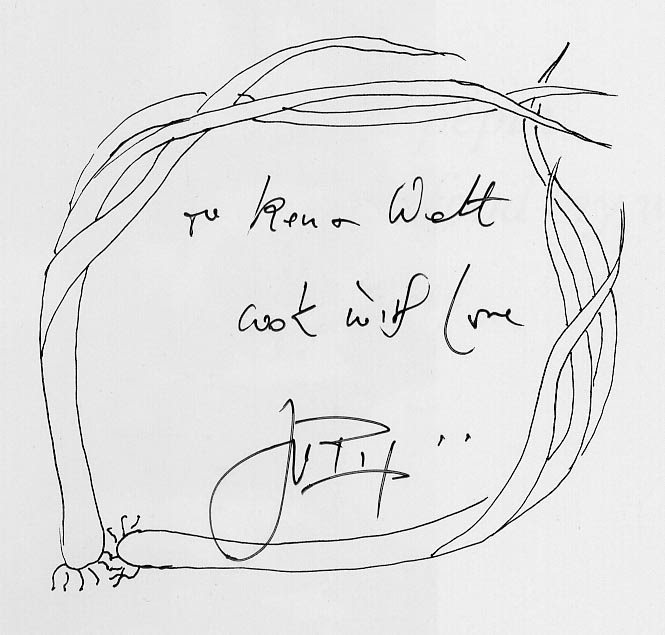Yesterday we got a really nice surprise — a present — in the mail. It's a book. Here's the story.
Our blog friend Nadège, who often leaves comments here and on other blogs we read, is a makeup artist in Los Angeles. She's worked on Dancing with the Stars and many movies whose titles you would recognize. She rubs elbows with Hollywood stars. By the way, Nadège is French by birth, but she has lived in America for many years.
Autumn leaves in the Renaudière vineyard outside Saint-Aignan
Last year and again this year, Nadège has worked doing makeup for the hosts and guests on the ABC (American Broadcasting Company) cooking show called The Taste. The hosts of the show are Anthony Bourdain (American of French descent), Nigella Lawson (British), Ludovic Lefebvre (French but lives in the U.S. now), and Brian Malarkey (American).
I first became aware of Ludo Lefebvre a couple of years ago when I saw him doing a video clip with Bourdain that I found on the web. He prepared jambon à la chablisienne, and we had recently been to Chablis when I saw the video, so I made the dish and blogged about it
here. Bourdain and Lawson are well-known TV personalities in the anglophone world.
Anyway to get to the point, Nadège told me in an e-mail a month or two ago that one of the guests on The Taste was going to be the French-American chef, TV personality, and author named Jacques Pépin. Now if you're not American, you might never have heard of him. He's not much known in France, for example, or even in England, I think.
Jacques Pépin has been one of the biggest influences in my life as an amateur cook. After learning a lot about French foods and cooking from two women in France whose children and grandchildren were friends of mine, and who invited me not only to eat in their dining rooms but also help in their kitchens, I went back to America in the early 1980s. Walt and I lived in Washington, DC, and we started watching cooking shows on TV. I always tried to cook the way I had learned in France over the preceding decade.
We watched Julia Child, of course, and Jeff Smith, Graham Kerr, Martin Yann, Madeleine Kaman, Nathalie Dupree, and on and on. And we started watching Jacques Pépin's shows on public television. His cooking style and his personality exactly fit the approach to food and cuisine that suited my personality and taste. It was not fussy or rule-bound. For example, he likes to tell his viewers to try things in the kitchen that they might not be successful doing at first, but they will learn. "And if you mess it up," he would say, "nobody will put you in jail or anything. You'll just try again the next time."
More autumn vines
The only time I ever saw Jacques Pépin in person was once in the airport in San Francisco in the late 1990s. I was sitting in a café having, guess what, a glass of wine, waiting for my plane to start boarding, when I saw him walk by with a man who must have been his driver. Pépin lives in Connecticut, on the east coast, but all his TV shows are produced in San Francisco. When I saw him at the airport, I really wanted to go and talk to him, to thank him, but I didn't. I would have felt like some kind of stalker.
If you don't know Jacques Pépin, you can see
a video here, showing him making French
brandade de morue (codfish and pureed potatoes). Many other videos are posted on the same site (
the KQED blog).
Anyway, there was Nadège telling me she would be working with Jacques Pépin in L.A. I asked her to please write about the experience and send me an e-mail. She did. She said all the hosts of The Taste were in awe of him, considering him a mentor and one of the best cooks in America. And in addition he is so personable and helpful. Pépin's home region, by the way, is La Bresse, near Lyon and Le Beaujolais, where his mother had a restaurant (she's still living at age 99, Nadège told me). He worked as a chef in Paris for a few years before moving to the U.S. in the 1960s.

Then yesterday, I got a small package in the mail. It was a book by Jacques Pépin that I don't have (but my friend CHM tells me he has it and likes it) called Fast Food My Way. I've already picked out three or four recipes I want to make. And best of all, Nadège asked Jacques Pépin to autograph it for us. He did a little drawing and wrote "To Ken and Walt, cook with love" and signed his name of course. That's his inscription up toward the top of this post.
I want Nadège to know that I think her gesture and gift are really meaningful, even moving. I have no way to thank her except to acknowledge her kindness and thoughtfulness here, in public.


















































